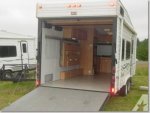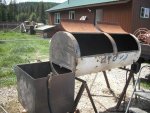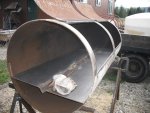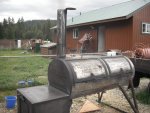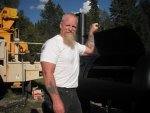- 806
- 831
- 93
- Location
- W.WA
So, I'm about a third the way through my 30 point "checklist of fun" and I'm thinking about item 20, the camper.
Is there anyone here that knows more than the average person about structural tubing, aluminum vs steel vs ?? that I can pick their brain with a few questions? I'm also wondering if I should consult a profession for $$, but it's such a small job that I don't know that I could get a pro to take an interest w/out ponying up a lot of $.
I've found some calculators on line for tubing.
Essentially, I need to span the length of the interior of the bed (87") suitable for holding 500 lbs, with little give. The reason for the 500 lbs (and there is wiggle room in this figure), I want to suspend a double-sized bed in a custom frame (& 2 occupants) from the cross beams that would then swing up to nestle against the ceiling. Also, I could see having guests on the roof, walking around.
The floor also needs strength. I plan on having a custom (90g) fuel tank built that would sit below the floor (between floor & bed) and it's probably cheaper to reinforce the floor to bear weight than to have the tank bear any. I will also have a clean water tank & grey water tank in this space between the floor & bed. I don't plan on having any parties inside this thing, so the floor would only need to support 1-2 people moving around.
If I use steel, I may weld it myself (100 hours welding classes in steel). I don't feel confident welding aluminum and would probably hire a pro driving the costs way up, I may hire a pro either way as it's a relatively small job and if I design it right and buy and cut the material myself I can save that way.
I suspect the frame will signify one of the heaviest portions of this camper build. It's such a small project that I don't know that I would realize a significant savings in weight by going with aluminum. While Al is considerably lighter than steel, it's not as strong and increasing the size of the Al also contributes to a corresponding increase in $, and it's more expensive to begin with.
Right now I'm thinking something in the realm of 2" tubing. I don't want too big a tube because space is an issue, but I will also line the walls between studs with sound insulation. I'm not too worried about R value as any heater I use will be overkill + blankets.
There is more that I've thought of, but this is the general idea and this post is already pretty long.
Oh, right wind shear...it's going to be on a vehicle with a top speed of 62mph. but I could also see this thing being parked in coastal places and experiencing 100mph (+?) wind gusts. I am planning on using a wall cladding that's used on office buildings.
Is there anyone here that knows more than the average person about structural tubing, aluminum vs steel vs ?? that I can pick their brain with a few questions? I'm also wondering if I should consult a profession for $$, but it's such a small job that I don't know that I could get a pro to take an interest w/out ponying up a lot of $.
I've found some calculators on line for tubing.
Essentially, I need to span the length of the interior of the bed (87") suitable for holding 500 lbs, with little give. The reason for the 500 lbs (and there is wiggle room in this figure), I want to suspend a double-sized bed in a custom frame (& 2 occupants) from the cross beams that would then swing up to nestle against the ceiling. Also, I could see having guests on the roof, walking around.
The floor also needs strength. I plan on having a custom (90g) fuel tank built that would sit below the floor (between floor & bed) and it's probably cheaper to reinforce the floor to bear weight than to have the tank bear any. I will also have a clean water tank & grey water tank in this space between the floor & bed. I don't plan on having any parties inside this thing, so the floor would only need to support 1-2 people moving around.
If I use steel, I may weld it myself (100 hours welding classes in steel). I don't feel confident welding aluminum and would probably hire a pro driving the costs way up, I may hire a pro either way as it's a relatively small job and if I design it right and buy and cut the material myself I can save that way.
I suspect the frame will signify one of the heaviest portions of this camper build. It's such a small project that I don't know that I would realize a significant savings in weight by going with aluminum. While Al is considerably lighter than steel, it's not as strong and increasing the size of the Al also contributes to a corresponding increase in $, and it's more expensive to begin with.
Right now I'm thinking something in the realm of 2" tubing. I don't want too big a tube because space is an issue, but I will also line the walls between studs with sound insulation. I'm not too worried about R value as any heater I use will be overkill + blankets.
There is more that I've thought of, but this is the general idea and this post is already pretty long.
Oh, right wind shear...it's going to be on a vehicle with a top speed of 62mph. but I could also see this thing being parked in coastal places and experiencing 100mph (+?) wind gusts. I am planning on using a wall cladding that's used on office buildings.
Last edited:





